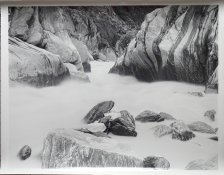My biggest tip for burning with cards? Use duplex paper (black one side, white on the other). It's expensive but you can make it with a can of spray mount, black poster board and white printer paper. You can see the negative image - even if it's blurred by height - and align things much more easily. If you find a specific height works well, stack some books on the easel to that height, project the neg on the white side, and draw the main shapes if the image with a sharpie. Makes it even easier to align the thing (you do have to remove the books, they're just to hold the card steady while you draw on it).
Tip #2 - keep a scrap of red lighting gel handy. If you're doing a 10 second burn, set your timer for 14 seconds, and hold the card with the gel over the hole. Hit the timer and you have 4 seconds to align things, then just slide the gel away with your thumb. You can make very precise burns this way. (An audible enlarger with a foot switch is, of course, a monster upgrade for this kind of work).
I have a pin registered masking setup and I can create soft masks with it, but I still use cards for many things.




